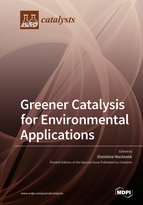Greener Catalysis for Environmental Applications
A special issue of Catalysts (ISSN 2073-4344). This special issue belongs to the section "Environmental Catalysis".
Deadline for manuscript submissions: closed (31 December 2020) | Viewed by 50128
Special Issue Editor
Interests: environmental chemistry; sustainable chemistry; water and wastewater treatmentł advanced oxidation processes
Special Issues, Collections and Topics in MDPI journals
Special Issue Information
Dear Colleagues,
Catalytic reactions form around 85% of all chemical reactions, being especially important in environmental science. It has been more than 20 years since Anastas and Warner introduced their 12 postulates of green chemistry, of which the 9th is catalysis. There have been continuous developments in catalysis regarding environmental applications, which are embodied in the exponential growth of scientific articles (published annually) concerning that topic.
This Special Issue is devoted to ‘’Greener Catalysis for Environmental Applications’’, and primarily covers the catalytic removal of pollutants (from water, wastewater, soil, and air) as well as the catalytic synthesis of value-added chemicals (for example, in nonthermal plasma catalytic systems).
Articles focusing on the catalytic activation of oxidants and green syntheses of sophisticated catalysts for various environmental applications are particularly welcomed. Primarily, the following topics are planned to be covered in this Special Issue:
- Green synthesis of heterogeneous catalysts;
- Catalytic activation of oxidants (advanced oxidation processes; sulfate radical-based processes);
- Photocatalysis for the removal of, e.g., micropollutants;
- Catalytic hydrogenation of carbon dioxide into value-added chemicals and fuels;
- Catalytic hydrogenation of contaminants in water;
- Nanozymes for environmental applications.
All studies (experimental and theoretical) in the scope of this Special Issue, including original research and review articles, short communications, and perspective articles, are invited for submission.
Dr. Stanisław Wacławek
Guest Editor
Manuscript Submission Information
Manuscripts should be submitted online at www.mdpi.com by registering and logging in to this website. Once you are registered, click here to go to the submission form. Manuscripts can be submitted until the deadline. All submissions that pass pre-check are peer-reviewed. Accepted papers will be published continuously in the journal (as soon as accepted) and will be listed together on the special issue website. Research articles, review articles as well as short communications are invited. For planned papers, a title and short abstract (about 100 words) can be sent to the Editorial Office for announcement on this website.
Submitted manuscripts should not have been published previously, nor be under consideration for publication elsewhere (except conference proceedings papers). All manuscripts are thoroughly refereed through a single-blind peer-review process. A guide for authors and other relevant information for submission of manuscripts is available on the Instructions for Authors page. Catalysts is an international peer-reviewed open access monthly journal published by MDPI.
Please visit the Instructions for Authors page before submitting a manuscript. The Article Processing Charge (APC) for publication in this open access journal is 2200 CHF (Swiss Francs). Submitted papers should be well formatted and use good English. Authors may use MDPI's English editing service prior to publication or during author revisions.
Keywords
- Greener catalysts
- Green synthesis of nanoparticles
- Photocatalysis
- Nanozymes
- Catalytic activation of oxidants
- Catalytic reduction of pollutants
- Catalytic water and wastewater treatment
- Value-added products from renewable sources.
Benefits of Publishing in a Special Issue
- Ease of navigation: Grouping papers by topic helps scholars navigate broad scope journals more efficiently.
- Greater discoverability: Special Issues support the reach and impact of scientific research. Articles in Special Issues are more discoverable and cited more frequently.
- Expansion of research network: Special Issues facilitate connections among authors, fostering scientific collaborations.
- External promotion: Articles in Special Issues are often promoted through the journal's social media, increasing their visibility.
- Reprint: MDPI Books provides the opportunity to republish successful Special Issues in book format, both online and in print.
Further information on MDPI's Special Issue policies can be found here.






